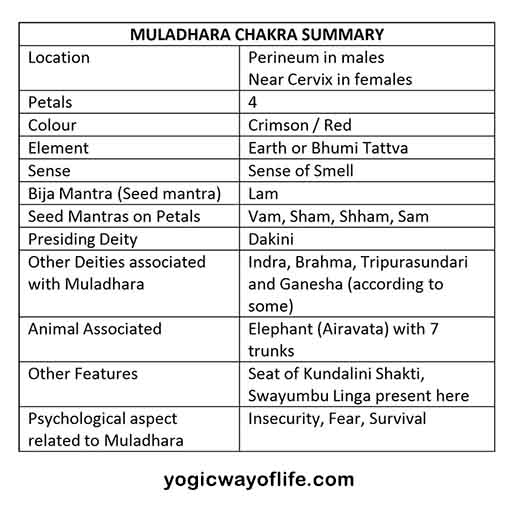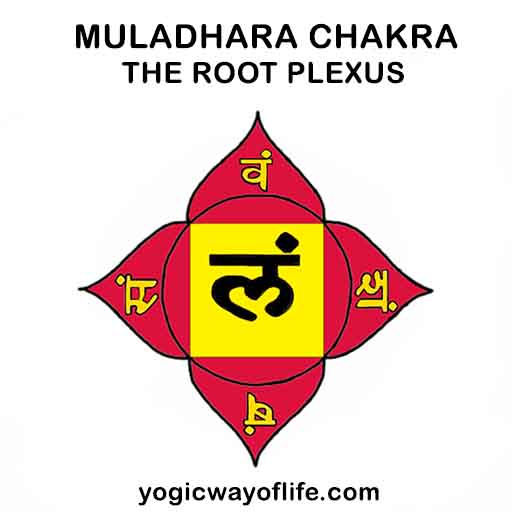Muladhara Chakra or the Root Plexus is the basis of our physical nature. In Sanskrit, Mula means root, Adhara means place or base location and Chakra means a wheel or vortex or energy. Muladhara chakra is considered the resting place of the Kundalini Shakti, the inner dormant energy, which when awakened, gives great spiritual, mental and physical benefits. According to tantric texts, there are seven chakras or plexuses. Muladhara is the first or the root plexus.
Location of Muladhara Chakra
Muladhara chakra is located inside the perineum in male, between the scrotum and testes. It is placed above the anus and below the genitals. In females it is located close to the cervix. The chakras are more connected to the pranic body. Muladhara chakra is not part of the physical body but does influence the organs around the perineum, especially the excretory, urinary, sexual and reproductive organs.
Traditional symbolism of Muladhara Chakra
In tantra, every chakra is depicted as a flower with many petals. There are many texts that describe the Muladhara Chakra. The most vivid among them is the Shad Chaka Nirupana, which has been translated to English by Sir John Woodroffe in his book, The Serpent Power.
Muladhara Chakra is described as a flower with 4 petals. The petals are crimson in colour. On the petals is found the seed letters Vam, Sham, Shham and Sam written in golden colour. In the centre or pericarp of the flower is a yellow square. The square symbolises the Bhumi Tattva or element of earth and is surrounded by 8 spears. Within it, in the lower part is the Dhara-Bija or letter Lam. Inside it is the Bija of Indra, with four arms and seated on elephant Airavata with 7 trunks. He is yellow in colour and has the thunderbolt in his hands. In his lap, is the Child Brahma, who is red in colour and has four faces and four arms in which he holds staff (Danda), gourd (Kamandalu), Japa mala of rudraksha beads and gesture of dispelling fear.
Inside the pericarp of the flower there resides the Deity of the Muldahara Chakra called Dakini. She is red in colour and has four arms
On the elephant’s back, in the centre of the yellow square is a red inverted triangle. The inverted triangle symbolises the feminine force or Shakti or Goddess. This Shakti or Goddess is Tripura. Inside the triangle is a Linga or symbol of Shiva which is smoky in colour. Coiled around the Linga is the Kundalini Shakti in three and half coils, as lustrous as lightning. The three coils represent the three Gunas of Tamas, Rajas and Sattva. The half coil represents transcendence.
Seed Mantras associated with Muladhara Chakra
Seed Mantras or Bija Mantras are one letter syllabled mantras with hidden power. The mantra for Muladhara Chakra is Lam. Practitioners use the repetition of this seed mantra to activate the chakra.
Apart from this, the petals of the chakra also have seed letters associated with it. The petals of Muladhara chakra has these 4 letters – Vam, Sham, Shham, Sam written on it. These are also used by practitioners while visualising the chakra.
Presiding Deity of Muladhara Chakra
Each chakra has a presiding divinity or deity, also known as Chakradhistadhatri. Goddess Dakini is the presiding deity of Muladhara. She is depicted with 4 arms and brilliant red eyes. She shines like the lustre of a many suns rising at same time. Goddess Dakini is the carrier of revelation of the ever-pure intelligence.
Sense Organ connected with Muladhara Chakra
In tantra, Muladhara Chakra is related to the nasal cavity and the sense of smell.
How to Activate Muladhara Chakra?
There are many ways of activating a Chakra or plexus. One way is the use of Bija Mantras (One syllabled sacred sounds). The bija Mantra of Muladhara Chakra is Lam. Chanting of the seed syllable Lam can be used to activate Muladhara chakra.
Another way is to do Nasikagra Dhristi or Nose tip gazing. Since the Muladhara Chakra is connected to the sense of smell; hence this technique is used to activate the root plexus.
Mula Bandha (Perineal Lock or the Root Lock) can also be used to activate this chakra. Apart from these, there are tantric methods of visualisation and meditation of the chakra to develop the full potential of the plexus.
Muladhara Chakra and Brahma Ghranti
Muladhara is a very important centre in the evolution of man. It is more connected to instinctive life and unconscious behaviour. This programming of instinctive life is represented as a knot called Brahma Ghranti, the knot of the creator. When this knot is opened by spiritual practices, the energy or Shakti awakens and tries to move upwards.
Muladhara and Chakra Psychology
Each plexus is associated with the quality of the mind and the evolution of the person. Muladhara is the lowest chakra in the evolution of man and deals with insecurity and fear. It embodies the quality of the instinctive man. It is the carry-over of the animal trait in man. It has the quality of Tamas or inertness. All the passions, feeling of guilt, various complexes, etc. are stored in the Muladhara. People with block in this chakra experiences insecurity in every sphere of life.
Muladhara is an important centre for practitioners of yoga. Activating this root centre is required for releasing the instinctive energy as well as to awaken the kundalini Shakti.


